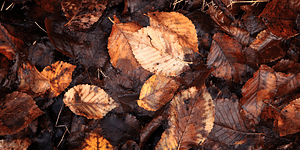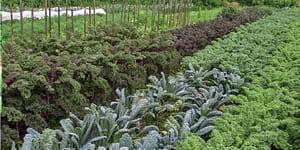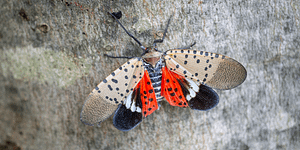It’s Raining, It’s Pouring, the Rain Garden is Growing

With temperatures rising and the summer heat in full swing, your plants and crops need as much water as they can possibly get. What better way to do that than building your own rain garden? A rain garden will absorb rainwater run-off and use this water to then help grow the plants planted in the area.
The following is an excerpt from The Ecological Gardener by Matt Rees-Warren. It has been adapted for the web.
Rain Garden and Retention
Of course, not everyone has the space to dig a pond, or slopes that could lend themselves to swales. Maybe your garden has lots of impermeable hard standings like concrete patios and driveways, or drains and gutters that just cannot link to any collection systems.
If that’s the case, it’s advantageous to divert the water – which will more than likely be channelled to a storm drain – towards a rain garden. Rain gardens are dedicated areas of planting that absorb rainwater run-off, much like a soak-away, but they use this water to grow plants before sending it into the subsoil.

Using Soils & Mulch
Soils that are left bare and exposed are far more likely to allow water to run off their surface than soils covered in mulch. Mulch absorbs the water and allows it to percolate slowly through its organic mass, eventually providing a far greater volume of water to the soil below and thereby the roots of the plants. In periods of drought or drying winds, mulch locks in moisture present in the soils and protects it from evaporation on its surface.
Any organic sheet mulch will do this to some degree, but thick layers of compost will not only be the most beneficial to the soil but also the most similar to natural processes. Keep the mulch permanently over your soils by applying it in both the spring and autumn, and you can also follow a cut-and-drop method during the summer.
Cut-and-drop mulching involves leaving the material left from pruning or cutting exactly where it falls; for example, if you prune a tree the cuttings will fall at the base of the tree. Or, if you grow plants like borage (Borago officinalis) or comfrey (Symphytum officinale), grow them deliberately under hungry plants like fruit trees. The leaves left on the ground will act as mulch and food for the soil. Whichever method you employ, mulching is an essential art that works alongside rainwater harvesting techniques and is a fundamental requirement in ecological gardening.
Starting a Rain Garden
What you choose to plant will vary, dependent on your garden’s climate. Gardeners working in dry, arid climates often use rain gardens to grow a variety of plants, while those in wet, temperate climates will necessarily employ a more wet-tolerant bog planting style described here.
1. Locate an area where rainwater runs off a hard standing – like a driveway, patio or path – and straight to a storm drain.
2. Pick a section immediately adjacent to the hard standing, then look to divert the water flow to this point by either removing edging, bricks or paving; or, by creating rills and gullies.
3. Dig a wide, saucer-shaped pit in the section and use the soil to form a berm around the edge, making sure the pit sits below the hard-standing level, then cut a channel in the berm.
4. Line the bottom half of the pit with gravel, add a gritty soil/ compost mix, then plant up with wet-tolerant bog plants, such as yellow flag iris (Iris pseudacorus) and meadowsweet (Filipendula ulmaria).

The run-off from the hard surface has been deliberately diverted to the rain garden. Photo by BrianAsh/Wikimedia Commons.
Recommended Reads
How to Grow and Maintain Fruit Trees: General Fruit Tree Management
Recent Articles
Seeds strengthen our connections to what we grow and eat; they are intrinsic to our identity and our future. I cherish seed as a common resource that all the world should be able to access freely.
Read MoreMulch is essential to soil health. It acts as a barrier against water loss and heat, reduces weeds and improves soil structure. Its an easy way to boost your soil’s health!
Read MoreWith more than 80 percent of the US population now residing in urban areas food forests help provide a local food source. And they also serve as perfect platforms for community-building.
Read MoreWeeds are the bane of every farmer and gardener’s existence. Before you go crusading against the weeds in your garden follow these tips and tricks!
Read MoreWe’ve been told to kill a lanternfly because they’re “invasive.” In reality, they are living like any other insect would. So why are they under attack?
Read More







